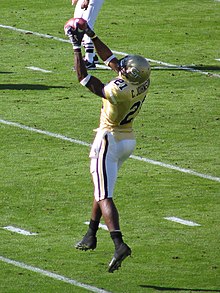
Back وايد ريسيڤير ARZ Wide receiver Danish Wide Receiver German Wide receiver Spanish Laitahyökkääjä (amerikkalainen jalkapallo) Finnish Wide receiver French Wide receiver Hungarian Ricevitore (football americano) Italian ワイドレシーバー (アメリカンフットボール) Japanese 와이드 리시버 Korean
This article needs additional citations for verification. (March 2022) |


A wide receiver (WR), also referred to as a wideout, and historically known as a split end (SE) or flanker (FL), is an eligible receiver in gridiron football. A key skill position of the offense, WR gets its name from the player being split out "wide" (near the sidelines), farthest away from the rest of the offensive formation.
A forward pass-catching specialist, the wide receiver is one of the fastest players on the field alongside cornerbacks and running backs. One on either extreme of the offensive line is typical, but several may be employed on the same play.
Through 2022 only four wide receivers, Jerry Rice (in 1987 and 1993), Michael Thomas (in 2019), Cooper Kupp (in 2021), and Justin Jefferson (in 2022), have won Offensive Player of the Year.[1] In every other year it was awarded to either a quarterback or running back. No wide receiver has ever won MVP. Jerry Rice is the leader in receptions, receiving yards, and touchdowns on the all-time list for receivers, along with being a 3-time SB champion and 10-time All-Pro selection.
- ^ Hope, Dan (July 7, 2013). "Ranking the Top 25 NFL Offensive Player of the Year Candidates". Bleacher Report. Retrieved May 26, 2017.
The award is typically given to the league's most productive quarterback or running back. Of the 41 times it has been given, it's been won. The exception is San Francisco 49ers wide receiver Jerry Rice, who won the award in both 1987 and 1993
.
© MMXXIII Rich X Search. We shall prevail. All rights reserved. Rich X Search